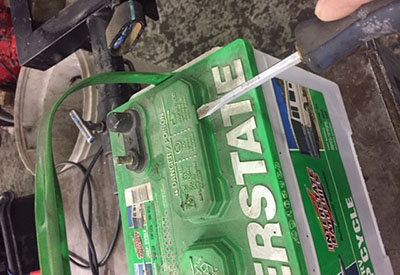Ask Andrew: Battery Maintenance – How do I maintain my conventional batteries?

Dec 14, 2017
Inserting a screw-driver to remove the maintenance cover
whether you choose power or sail (or both) batteries are an important part of your boat’s electrical system. Batteries provide the power needed to start engines or generators, and to run the electrical appliances onboard while at dock or underway.
Boat builders are getting better and better at making onboard power easy for us and battery manufacturers continuously improve the design and ‘maintenance-free’ aspects of their products. But, I don’t think it’s too far a stretch to think that most of us use the conventional battery – the type that is the least expensive, and lightest to carry.

Cover removed showing the fill holes and lead plates inside.
These batteries – called lead-acid type – are essentially as described: a series of lead plates, immersed in an acid solution. The chemistry gets a bit complicated (and forgive me for oversimplifying this), the liquid solution changes over time, moving in composition between acid and water, depending on the amount and frequency of recharging. When the battery is fully charged, it is more acidic. When the charge is depleted, it is more like water. When the battery is left depleted, over time the water will evaporate, lowering the level of the solution inside the battery.
These types of batteries are designed to be maintained, in two ways:
1) Keeping a charge up, by running a battery charger periodically, as the voltage drops over time
2) Adding distilled water to the battery if the level of solution inside drops below the top of the lead plates inside. The top of these batteries can be removed – a flashlight can be used to see the top of the solution inside – and distilled water added to each hole (carefully, using a funnel). Protective gloves and eyewear should be used during this procedure. Once filled, the battery should be left to slowly charge (also called trickle charging.
Battery maintenance has been talked and written about in many articles and books and many boaters are familiar with these procedures. Butmaintenance is becoming more and more important as electronics become more sophisticated.
AC appliances on boats are run by shore power (or a generator). Without shore power or a generator, the AC appliances don’t work.
However, DC appliances can run anytime and anywhere, as long as there is enough battery power to support them. While underway (away from shore power) batteries support all the lights, electronics, starting power for engines, VHF radio, fridge, pumps, instruments etc. With more and more sophisticated equipment onboard, batteries are being used more frequently, handling bigger loads, being regularly depleted and recharged, requiring maintenance more often.
What many of us forget, though, is that the batteries are still doing all of that work while plugged into shore power at dock. Here’s how that works: If you run your DC fridge at dock all weekend, the batteries are powering that fridge. The shore power is simply providing power to the battery charger to recharge the batteries regularly over time. Over a single weekend with a few appliances running, the batteries may be depleted and charged again numerous times.

3 types of conventional batteries
If this process is done over and over again without checking fluid levels, the batteries could become ‘cooked’: the lead plates inside are trying to provide power (or be recharged) without enough fluid to support the process. The lead plates heat up, chemical reactions occur inside and the battery melts or causes a fire.
Similarly, when storing for long periods of time (over the winter, as an example), batteries should be left in a fully charged state (so that the solution inside is an acidic solution, rather than water – which won’t freeze), with the cable(s) on the negative terminal left disconnected (this prevents any slow discharge from appliances connected directly to the batter over time).
For winter storage – these batteries are designed to be in sub-zero temperatures, provided that they are fully charged before storing for winter. With a full-charge, it is safe to leave batteries aboard, with the negative (black) cables disconnected from the battery. If the batteries are removed from the boat, they should be kept in a cool, dry place (basement or garage). When removing the battery cables, its good practice to clean the battery terminals and ring terminals with emery paper, and to apply petroleum jelly (Vaseline) to the battery terminals.
Maintenance is important – both as a safety concern, as well as to your pocketbook. Taking care of batteries in the short term will allow them to function properly, in the long term.




























